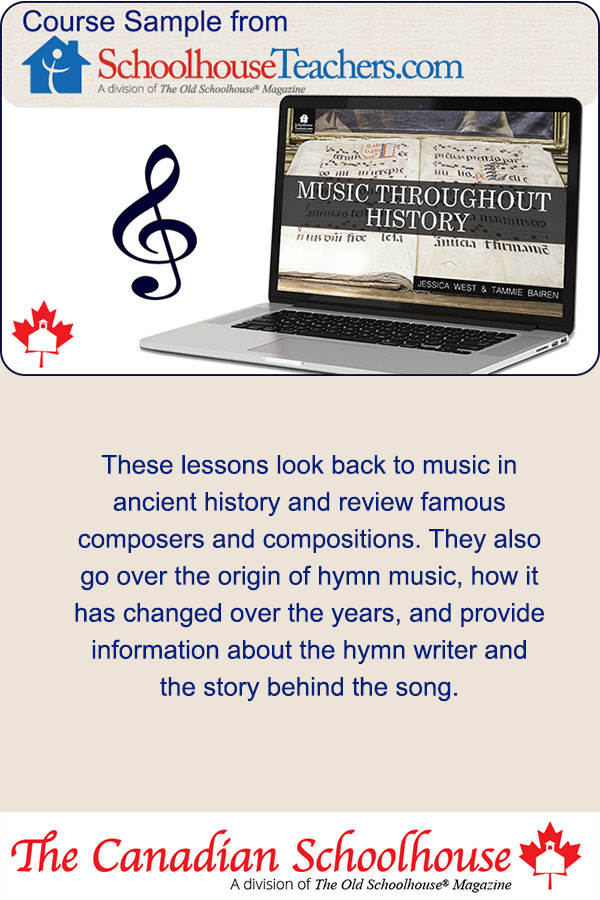

Music is an important and enjoyable part of most people’s everyday lives. We listen to it to worship the Lord, to accompany us in certain tasks and activities, and to give us a reason to dance and move! Over the years, music has been a part of the human experience and that experience has been compiled in a high school SchoolhouseTeachers.com course Music Throughout History.
These lessons look back to music in ancient history and review famous composers and compositions. They also go over the origin of hymn music, how it has changed over the years, and provide information about the hymn writer and the story behind the song. These stories show how we can grow closer to God and be inspired by life events to show Him at work in our lives.
Your child will learn new terminology and words that are associated with music. At the end of the course, they may even be able to compose their own original musical compositions! Each lesson will give lots of information that will help your child understand the way music is read and how to compose it. There is a history of words and composers throughout the course. At the end of each lesson, they will have questions to answer about what was covered in that particular lesson.
If you're not a SchoolhouseTeachers.com member, you can use this sample lesson as a stand-alone teaching that covers music of the medieval era. The complete lesson is seen below, but you can get a printable PDF through the Course Sample link on the Music Throughout History about page.
If you are a SchoolhouseTeachers.com Ultimate member, then you've got access to the whole course, but we hope this short sampling has introduced you to one of our great courses that you may not have found yet.

Lesson 1: Medieval Era (A.D. 500–1400)
Definitions of several musical terms begin the lesson. See the Sample Lesson for the vocabulary list.
We will begin our discussion with the medieval period, which begins with the fall of the Western Roman Empire in A.D. 476. The only music that has survived before the 800s is plainsong. This is also called plainchant. The music was mostly liturgical and used in the Western Church which, at that time, was the Catholic Church. (The Catholic Church was the only church until the Reformation in the 1500s.) Chanting of the medieval era was given the name Gregorian chant after Pope Gregory I.
Gregorian chants—typically chanted by monks—were monophonic. There was only one voice (one note, even if there was more than one chanter) and no instrumental accompaniment. The plainchants provided a calm and meditative atmosphere for prayer. Listen to an explanation and example of monophony [on YouTube].
As the medieval era progressed, music changed. Beginning in the 800s, the church opted to use Gregorian chant only. The earliest style of polyphony came into existence, and musical notation was reinvented.
Polyphony would become the predominant style of music through to the era of classical music. The earliest style lasted from the 800s to the mid-1200s; it was called organum. This consisted of neumatic chants and melismatic chants—the distinction being 2-6 and six or more, respectively. Here is an example of organum [on YouTube]. (The video is more than seven minutes long; feel free to stop after one.)
As polyphony progressed, schools of practice came into existence to teach this style. The St. Martial School was a compositional style that was similar throughout a region of France, followed by the Notre Dame School of Polyphony which lasted until 1250. The Notre Dame School was a group of monks who composed in a similar style and who were supported by the Notre Dame Cathedral. Two of the composers we will learn about were Léonin and Pérotin. An anonymous source called them “the best composers of organum.” Together, they compiled Magnus Liber Organi—the big book of organum.
Though notation had once been used, it fell out of use centuries before medieval times. The notation, however, provided no pitch or rhythm. The image to the right is an example of medieval notation. Before notation, music could not be taught to a large number of people as it had to be learned by ear, and it could not be spread far beyond the area in which it was learned. Think about stories told by native people before a written language was developed. These old stories were handed down by word of mouth. The only way subsequent generations could retell the stories was by remembering what had been told to them by their ancestors. If they didn’t share them, the stories would cease to exist. Having a way to write music allowed many people, even people far away, to learn it and play it.
Church music was not the only form of music during the medieval era. There was also secular music. French poets called troubadours and trouvères were among the first people to write secular music. The subject of their songs was usually love. They would play their music in castles, taverns, and town squares, wherever the road led. They were also a source of information and news for the towns they visited. Besides the vocal component of songs, there were instruments. Many of them you will probably recognize by name though there are some differences between what we know and what they were like centuries ago. See a list of these instruments. Some of them have a short recording along with their description. The pan flute was very popular during this time, and musicians used many string-like instruments such as the lute. One interesting instrument is the hurdy-gurdy.
There were many composers during this time. They can be divided into early medieval composers, middle medieval composers, and late medieval composers.
Early Medieval Composers (before A.D. 1150)
Saint Romanos the Melodist was born in Syria. He was a hymnographer; he wrote hymns. It is said he composed 1,000 during the first half of the sixth century. The subject matter of his hymns included the lives of the saints, festivals, Christ’s resurrection and crucifixion, among others. He was born around 490 and died around 555. Listen to a recording of one of St. Romanos’s works: https://www.youtube.com/watch?v=-hZJc_s9F3s.
Saint Yared was highly influential in the Ethiopian Orthodox Church. He was a musician whose songs, or chants, spoke of the various aspects of the life of Christ. They are still used today. He was born in 505 and died in 571. Here is a recording of one of his hymns (you only need to listen to 30 seconds to gain an appreciation): https://www.youtube.com/watch?v=hDJDF4QBzxQ.
Guido of Arezzo was an Italian whose musical notation was the basis for the modern system of notation. His treatise Micrologus was widely distributed during the medieval era. It outlines rules for the Gregorian chant and discusses polyphonic music. He was born c. 991 and died c. 1033. Learn more about Guido, his system of musical notation, and the role it played in the solfège system we use today: https://www.youtube.com/watch?v=l-JMX7tVqog.
Hildegard of Bingen spent most of her life in a small area of a monastery (away from the monks). During this time, she heard the chants of the mass but never composed anything until she became prioress. (She was in charge of the other nuns.) At this point, she began composing. Her Ordo Virtutum is a liturgical drama set to music. Much of her music is labeled as monophonic. She was born c. 1098 and died c. 1179. Here is a sample of her Ordo Virtutum: https://www.youtube.com/watch?v=wGPZWUNwLG0.
Go to the Sample Lesson PDF to see the composers of the middle and late medieval time as well as the Lesson 1 Worksheet with questions for your teen to answer about the Medieval Era of music.
More About This Course
The Music Throughout History journey spans thirty-six lessons, a full academic year’s worth of content. High school homeschool students explore different eras of time and the music common to each time period. Students study famous composers as well as many who are lesserknown. Homeschool music lessons also focus on hymn writers and how music in America has changed and developed over time. The Music Throughout History homeschool course wraps up by tying all the course components together and discussing how the student can create an original musical composition.
Get your PDF copy of this sample lesson from the Music Throughout History course.
If you’d like to see all that SchoolhouseTeachers.com has to offer your family (one membership price for every member of your family – including access to lots of parent resources!), then go to the membership page for all the pricing options.

















